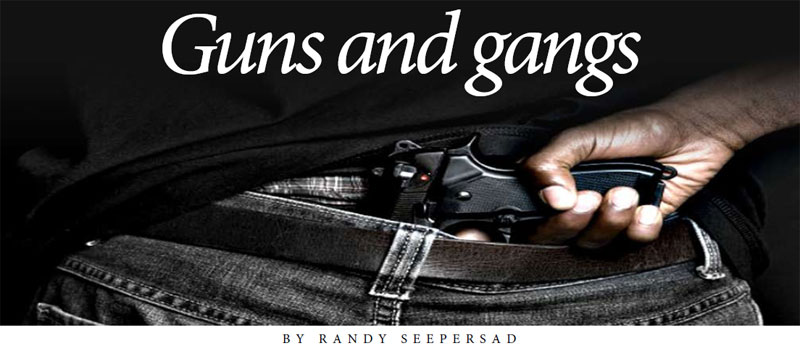 |
 |
 |
|
June 2012
|
Additional evidence that gangs are responsible for a disproportionate number of violent crimes derives from homicide data from the Trinidad and Tobago Police Service. Fully one third of all murders for the period 2001 to 2009 are attributed to gangs. Even more troubling is the finding that the proportion of murders being committed by gang members is increasing over time. Whereas the proportion of murders committed by gang members for the period 2001 to 2003 was 11.3%, the proportion rose dramatically to 45.6% for the period 2007 to 2009. Gang murders exhibit a consistent increase for the period 2001 to 2008, with a slight decrease in 2009. It should, however, be noted that the observed increase in gang related murders could be due to increasing awareness and emphasis on gangs, or to the improved ability to solve murder cases. This argument implies that the proportion of gang related murders may have been high, even in the past, but is now only coming to light due to greater awareness of gang involvement in violent crime. At the same time, given the previously mentioned limitations in Trinidad and Tobago in assessing whether or not murders are gang related, it is quite possible that official data underestimate the proportion of murders which are committed by gangs. Gang activity is becoming more violent as evidenced by the increasing number of murders committed by gang members. Data from the Trinidad and Tobago Police Service also indicate that firearm usage has increased dramatically over time where murders are concerned. For the period 2002 to 2010, a total of 3264 murders were committed, of which 2421 or 74% were committed with the use of a firearm. Indeed, as Figure 16 indicates, firearms have become the weapon of choice where murders are committed. Prior to 2000, firearms were used in fewer than one third of all homicides in Trinidad and Tobago, whereas after 2000, firearm usage in homicides consistently increased to the point where at present, firearms represent by far the predominant type of weapon used in homicides. These data imply that at least an appreciable proportion of gang related murders are committed with the use of firearms. The link between gangs and firearms is a troubling one. Firearm usage has increased over time for a range of additional crimes including wounding with intent and shooting with intent (see Figure 17). For the period 2002 to 2010, a total of 2164 woundings with intent were committed, with an annual average of 240. For this period, wounding with intent increased by an annual average of 13.4%. Shooting with intent exhibits similar upward trends. For the period for which data are available, there were a total of 1204 such shootings, with an annual average of 134. Shootings with intent increased at an average of 5.4% per annum. The only crimes in which firearms were used and in which there were decreases were robbery with aggravation (an annual average decrease of 2.7%) and robbery with violence (an annual average decrease of 0.3%). While there were observed decreases in these crimes, the quantum of such crimes nevertheless is cause for concern. With respect to robbery with aggravation, the annual average number of such crimes occurring is 1637 while the annual average number of robberies with violence is 455. —This is an excerpt from Randy Seepersad’s study, which will be published, in full, later this year in Professor Anthony Harriott’s book, “GANGS IN THE CARIBBEAN: Their Rise and impact on the patterns of crime, state and politics.”) |


 The most recent data on gangs in Trinidad and Tobago come from a United Nations Development Programme survey of 1595 adults in T&T. Respondents were 18 years and older, with data collected in November 2010. It was found that 14.5% of respondents indicated that gang violence occurred in their neighbourhoods in 2009, while 13.9% indicated that there was a criminal gang in their neighbourhood. Fully 18.4% of respondents indicated that gang violence was a somewhat serious, serious, or very serious problem in their neighbourhood. When the sample is restricted to persons who indicate that there is a criminal gang in their neighbourhood, fully 71.7% indicated that gang violence was a somewhat serious, serious, or very serious problem in their neighbourhood. When the entire sample is considered, 12% of the respondents indicated that gangs made their neighbourhoods lass safe, while only 0.6% indicated that gangs made their neighbourhoods safer. When the sample was restricted to only neighbourhoods with criminal gangs, 82.4% indicated that gangs made their neighbourhoods lass safe, while 3.2% indicated that gangs made their neighbourhood safer. Overall, 15.2% of the sample indicated that their neighbourhoods experienced a small amount of gang violence, 8.1% lived in neighbourhoods with some gang violence, while 2.3% lived in neighbourhoods with a large amount of gang violence. When the sample was restricted to only neighbourhoods with criminal gangs, 34.2% of the sample indicated that their neighbourhoods experienced a small amount of gang violence, 45.5% indicated that their neighbourhood had some gang violence, while 14.4% indicated that their neighbourhood had a large amount of gang violence. Quite importantly, it was found that 16% of respondents in neighbourhoods with gangs reported some form of criminal victimization, as opposed to 9.6% of respondents in neighbourhoods without gangs. Persons in neighbourhoods with gangs were almost three times as likely to be victims of violent crimes compared to persons in neighbourhoods without gangs (10.1% vs. 3.7%). Where property victimization is concerned, 5.3% of persons in neighbourhoods with gangs reported such victimization compared to 4.2% of persons in neighbourhoods without gangs.
The most recent data on gangs in Trinidad and Tobago come from a United Nations Development Programme survey of 1595 adults in T&T. Respondents were 18 years and older, with data collected in November 2010. It was found that 14.5% of respondents indicated that gang violence occurred in their neighbourhoods in 2009, while 13.9% indicated that there was a criminal gang in their neighbourhood. Fully 18.4% of respondents indicated that gang violence was a somewhat serious, serious, or very serious problem in their neighbourhood. When the sample is restricted to persons who indicate that there is a criminal gang in their neighbourhood, fully 71.7% indicated that gang violence was a somewhat serious, serious, or very serious problem in their neighbourhood. When the entire sample is considered, 12% of the respondents indicated that gangs made their neighbourhoods lass safe, while only 0.6% indicated that gangs made their neighbourhoods safer. When the sample was restricted to only neighbourhoods with criminal gangs, 82.4% indicated that gangs made their neighbourhoods lass safe, while 3.2% indicated that gangs made their neighbourhood safer. Overall, 15.2% of the sample indicated that their neighbourhoods experienced a small amount of gang violence, 8.1% lived in neighbourhoods with some gang violence, while 2.3% lived in neighbourhoods with a large amount of gang violence. When the sample was restricted to only neighbourhoods with criminal gangs, 34.2% of the sample indicated that their neighbourhoods experienced a small amount of gang violence, 45.5% indicated that their neighbourhood had some gang violence, while 14.4% indicated that their neighbourhood had a large amount of gang violence. Quite importantly, it was found that 16% of respondents in neighbourhoods with gangs reported some form of criminal victimization, as opposed to 9.6% of respondents in neighbourhoods without gangs. Persons in neighbourhoods with gangs were almost three times as likely to be victims of violent crimes compared to persons in neighbourhoods without gangs (10.1% vs. 3.7%). Where property victimization is concerned, 5.3% of persons in neighbourhoods with gangs reported such victimization compared to 4.2% of persons in neighbourhoods without gangs.